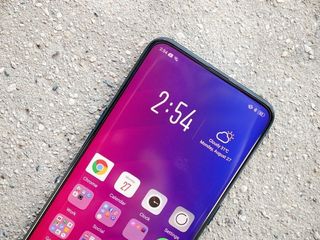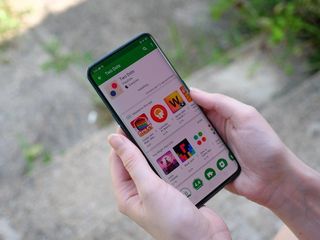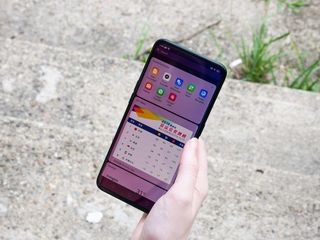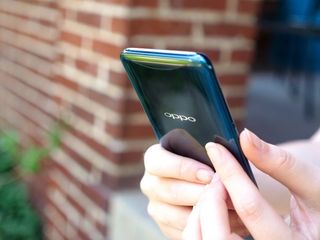The Find X feels like a direct response from OPPO to all of the jaded critics that love to say that smartphone designs have become "boring" or "iterative." It's hard to call this phone either of those things, with its incredibly unique slide-out camera panel and jaw-dropping bezel-less display. From a hardware perspective, this is probably the most interesting phone of the year, and maybe even a milestone for smartphones as a whole.
As with any industry-leading design, though, the phone isn't perfect, and that's before you even turn it on. Once you do, the Find X's software isn't nearly as futuristic as its hardware, and some of the ways OPPO changes the fundamental Android experience with ColorOS are hard to look past.
Pros:
- Gorgeous, unique design with high screen-to-body ratio
- Long-lasting battery
- Huge, bright display
Cons:
- ColorOS is a travesty
- Notifications are disabled on most apps by default
- Cameras aren't great for the money
- No water resistance or wireless charging
About this review
I (Hayato Huseman) am writing this review after using the Find X (PAFM00) for two weeks in Indianapolis and New York City on the AT&T network. The phone was running firmware version PAFM00_11_A.23_7cd29206 with ColorOS v5.1 based on Android 8.1 Oreo, and hasn't received any updates over the course of the review. The unit was purchased by Mobile Nations.
OPPO Find X Hardware

The Find X is one of the most unique phones I've ever used from a hardware perspective. There's just nothing like it, and that starts with its curved 6.4-inch display, front and center. It's a great Full HD+ AMOLED panel with good color reproduction and outdoor viewing angles, but that's clearly not its headline characteristic.
The display occupies an insane 93.8% of the face of the phone. Read that back, that's just a few points shy of a completely bezel-less, 100% screen-to-body ratio. That absolutely topples over phones like the Galaxy Note 9, Xiaomi Mi Mix 2, and even the Vivo NEX — the latter of which is closest in design to the Find X. While having virtually nothing but screen up front isn't always entirely practical (we'll get to that later), watching videos on this phone is nothing short of stunning, and it's an experience unlike using any other phone.
The biggest problem with the coveted bezel-less design tech enthusiasts lust over is that phones still need somewhere to put all of the various sensors that typically sit above the display — things like the ambient light and proximity sensors, the earpiece speaker, and the front-facing camera. Most manufacturers have started cramming those sensors into a notch at the top of the display, but OPPO had something different in mind.


The Find X's motorized camera panel is a stunning hardware component, but moving parts still give me pause.
At the top of the Find X is a motorized hidden panel that raises whenever you need to access the cameras and automatically tucks itself away when you're done. It's just as crazy as it sounds; you can actually hear and feel the motors whirring as the panel raises and lowers, and it's just wild to watch. While the Vivo NEX pulled off a similar design first with its motorized camera tab, this is the first phone with a raising panel spanning its entire width.
Now if you're worried about hardware longevity with a motorized panel … well, you're right to be. OPPO says it's tested its motor for up to 300,000 actuations, but at the end of the day it's still a moving part, and moving parts eventually break. If that happens with the Find X, you're not just out a cool party trick, you won't be able to access your cameras.
That's not just a big deal for photographers, either. Since the Find X doesn't have a fingerprint sensor, it instead relies on facial recognition for authentication. Just like the iPhone X, when you first set up the phone, it uses infrared to create a depth map of your face, then the panel quickly slides out to read your face every time you turn on the display.




The whole system works surprisingly well; the motor is fairly quick to extend and retract the panel as necessary, and the facial recognition is almost instant once the panel is out. The process isn't quite as fast as OnePlus's facial recognition or even Apple's Face ID, but we're talking a second longer at most — this is perfectly fine for daily use. Just like the alternatives, the Find X won't unlock if you're looking away, which is a good security measure. The only time the phone gives me any trouble is when I'm wearing glasses; it'll still recognize me eventually, but it often takes much longer than usual.
| Specs | OPPO Find X |
|---|---|
| Screen | 6.4-inch 19.5:9 (2340x1080) AMOLED |
| Chipset | Snapdragon 845 |
| RAM | 8GB |
| Storage | 128GB/256GB |
| Software | Android 8.1 Oreo, ColorOS 5.1 |
| Rear Camera 1 | 16MP, ƒ/2.0 |
| Rear Camera 2 | 20MP, ƒ/2.0 |
| Front Camera | 25MP, ƒ/2.0 |
| Security | Face unlock |
| Battery | 3730mAh |
| Connectivity | Wi-Fi 802.11 ac, Bluetooth 5.0 |
| Colors | Bordeaux Red, Glacier Blue |
| Dimensions | 156.7 x 74.2 x 9.6mm |
| Weight | 186g |
| Price | $960 |
It's almost a shame how much the motorized panel and bezel-less display steer the conversation away from the rest of the phone, because it's just as unique and gorgeous elsewhere. With all the cameras hidden away, the back of the phone is completely barren, with only the OPPO and Find X branding interrupting the otherwise blank slate. By this point, we're all programmed to avoid touching the upper third of the backs of our phones to keep from accidentally smudging the cameras, but it's oddly relieving to not have to worry about that here.
The Find X also has some pretty eye-catching, beautiful finishes. On my Glacier Blue unit, the center of the glass back is a glossy deep black, but the edges subtly fade into a gorgeous dark blue that permeates to the metal frame. The Bordeaux Red model features the same gradient effect, but with more of a dark magenta hue. They're both incredible finishes that are unlike anything I've seen on other phones.
Now despite all of the Find X's opulent hardware traits, there are a few letdowns here, too. There's no headphone jack, nor are there front-facing speakers — instead, there's a small speaker grill on the bottom edge that puts out disappointingly tinny audio. You also don't get wireless charging, despite this phone having a glass backing, but most damning of all, it isn't water resistant. This was a necessary trade-off to achieve the motorized panel, but it's disappointing nonetheless — this phone is far too costly to be wiped out by a rainstorm or spilled glass.
OPPO Find X Software

I've gushed on for nearly a thousand words about the Find X's incredible hardware, but the software is a different story entirely. OPPO's ColorOS software runs on top of Android 8.1 Oreo, but you'd never know it from using the phone. This is a fundamentally different Android experience than any Western user will be accustomed to, and the vast majority of OPPO's changes do much more to harm the experience than improve it.
From the moment you first set up the Find X, all of your apps are scattered across multiple pages of the home screen without an app drawer, iOS-style, and what would typically be the Google Feed to the left of the home screens has instead been replaced with OPPO's Smart Assistant. The latter makes sense, since Google's services aren't available in China, where OPPO originates, and Smart Assistant actually isn't bad; you can use it to quickly check the weather, track steps, see upcoming calendar events, and so on.
Android Oreo on the Find X is completely unrecognizable through all of ColorOS's changes.
The problems begin when you start trying to install … well, pretty much anything. OPPO has its own app store, but it's all in Chinese, even if you set the phone up in English, and the selection is miserable at best. Instead, you'll want to side-load the Google Play Store, which is as simple as downloading and installing the APK, but finding it takes a bit of work, no thanks to OPPO's browser, which — you guessed it — is all in Chinese.
Once you've installed the Play Store and started downloading your favorite apps, you'll likely start running into other problems. Using a third-party keyboard like Gboard works well enough, but much like iOS, the Find X reverts to its default keyboard any time you input passwords — a somewhat reasonable security measure, if not a bit annoying. If, however, you try to install a third-party launcher, you'll quickly find out that the Find X doesn't let you change launchers. The default launcher option in the system settings leads to a completely blank menu, no matter what you try, so … get used to ColorOS, I suppose. In fairness, OPPO says that's been fixed in a new software update, but I have yet to receive it on my unit.

I also had a ton of trouble with Google Maps on the Find X. On a recent trip to New York, I tried to pull up directions to my hotel from the airport, but the phone simply couldn't lock onto my location. Despite having a solid 4G connection, I waited almost five minutes before the phone could pull up directions, which were entirely wrong because the phone had pinpointed me at a completely different part of town. Eventually I had to just give up and grab my Galaxy S9 to navigate around, but most people who buy this phone won't have a spare to fall back on, and I can't say I'd be confident getting around town with the Find X.
It's easy enough to shrug these issues off and say that the phone wasn't intended for Western markets or Google Play services in the first place, but the troubles with ColorOS aren't exclusive to third-party apps. Dismissing individual notifications is a multi-step process now; you can't just swipe them away like most other phones. Instead, you'll have to swipe them to the left, which then slides out a trash icon you can tap to dismiss the notification. Every single time. For every notification.
ColorOS has a few convenient features, but it's so broken in its current state that it makes the Find X hard to use.
That's not so bad though, since you'll hardly receive notifications in the first place — at least, by default. After a few minutes with the Find X, you'll quickly start to notice that push notifications from apps aren't coming in. That's not because of aggressive background task management (though it has that, too) or a poor network connection; it's because by default, notifications are disabled for every third-party app. You actually have to go into the system settings and enable push notifications for each app individually. I can't overstate how awful of an experience this is, especially without a way to mass-approve every app at once.

These issues are a real shame because the phone actually runs very smoothly — though that's no surprise, given the Snapdragon 845 and whopping 8GB of RAM in tow. The software has some genuinely convenient and useful features, like the swipe-up gesture navigation that replaces the three-button layout to regain the bottom of the screen, or the app cloning that allows for multiple accounts on a single service like Facebook or Instagram. Sadly, though, the benefits of ColorOS are far outweighed by its shortcomings.
OPPO Find X Cameras
The Find X features two cameras on the backside of its motorized module, one a 16MP primary sensor and the other a 20MP depth sensor that aids in portrait mode photography — both with an ƒ/2.0 aperture. Considering the Find X is priced similarly to the Galaxy Note 9 and iPhone X, I was comparatively underwhelmed by its cameras, but they're still impressive given just how narrow the sliding enclosure for the cameras is.
Dynamic range is pretty great; I went on a hike with a few friends the other week, and even on darker paths shrouded from the sun by trees, the bright sky still came out blue in photos, rather than a blown out white. Colors are decent as well, if not a bit undersaturated, but I noticed a tendency for the cameras to overexpose. It's a quick enough fix in post, but I'd rather the phone just properly expose in the first place.















I'm mostly happy with the Find X's cameras in daylight, but it gets pretty rough in even the slightest of dark conditions. While on that hike, I missed a lot of shots later in the evening because the cameras are just too slow in the dark, and despite the 16MP sensor's built-in OIS, most of my photos came out blurry and undefined. Take the Find X into a truly dark environment like a bar, and it just gets worse. Colors become muddy and clarity becomes all but nonexistent. Low light is a weakness of any phone's cameras, but I had hoped for better from a thousand dollar phone.
What annoyed me most about shooting on the Find X is that the camera app has absolutely no settings. Save for the small bits of iconography strewn across the viewfinder, OPPO's camera software is a mostly take-it-or-leave-it experience, though I'm happy there's still at least a pro mode (OPPO calls it "expert mode") for manual controls. As far as video goes, you can shoot in 4K despite the display only reaching 1080p, but I more appreciated the option to shoot in 1080p at up to 120fps for smooth slow-motion shots.
OPPO Find X Battery Life

Battery life is actually one of the Find X's high points. It's a sizable 3730mAh, and combined with ColorOS's aggressive app management and the relatively low-resolution display (that's not a knock — 1080p is plenty good enough for most people), it's pretty hard to kill the phone in a single day.
Even with the unavoidable constant gaps in service of riding the New York City Subway, which are notorious for running down any phone's battery, the Find X always made it through the day for me, typically with 20 or 30% to spare by midnight.
ColorOS doesn't show screen-on time, but the Find X has no trouble making it through the day and then some.
If you don't like how often ColorOS closes out idle background tasks, you can actually disable its app management in the system settings, though that'll likely impact battery life pretty significantly. Then again, you're still working with almost 4000mAh, so while endurance may be a bit worse without what OPPO calls "app freezing," it'll still likely last you through the day without a hitch.
When the phone does run down, it features OPPO's VOOC rapid charging for quick top-ups. If you've ever used another phone from OPPO or OnePlus, you already know all about VOOC charging — it's insanely fast; even with a 3730mAh battery, the Find X can reach a full charge in less than an hour, so long as you use the included charger.

Even with a different charger, though, I was impressed with the charge times. I use my 15-inch MacBook Pro's 87W USB-C charger interchangeably with my laptop and phones, and I've found that the Find X charges fully in about 80 minutes.
The only letdown with the Find X's battery life is standby time. If I leave the phone off the charger overnight, it loses nearly 10% of its charge. With such aggressive throttling of idle apps, I'm really not sure what could be draining the battery so much with the screen off, but it's definitely been disappointing whenever I pull the Find X out of my bag after a flight and notice how much it's lost.
Should you buy it? Probably not
This far in, it's pretty easy to guess my feelings on the Find X. I can't remember the last time a phone's design has captivated me the way this one's has, from its unprecedented sliding mechanism to the incredible 93.8% screen-to-body ratio.
It's not flawless — the camera panel traps dirt and dust pretty easily, and there's no telling how long the hardware will last, both because moving parts eventually fail and because the phone isn't water resistant in any way. But it's no stretch to say that the Find X has some of the most fascinating and impressive hardware of 2018.
3 out of 5
Sadly, great hardware doesn't get you very far when the accompanying software is as big a disaster as ColorOS. From annoying systemwide quirks to downright broken third-party app support and a complete disabling of notifications out of the box, the software on the Find X seems to combine all the worst parts of iOS and Android into a jumbled mess that make the phone hard to use — and even harder to recommend.
If you're a hardware enthusiast with considerable money to spend, and you just want to marvel at the stunning design of the Find X, you can order one straight from Amazon for about $960. Who knows — with future updates that promise to fix broken features like the inability to use third-party launchers, the Find X might eventually offer a better software experience.
Until then, though, you can do a lot better than the Find X for a lot less money.
Hayato was a product reviewer and video editor for Android Central.

